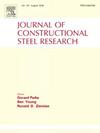Experimental and mechanistic study of mechanical property deterioration mechanism of Q235B steel under local stress corrosion action
IF 4
2区 工程技术
Q1 CONSTRUCTION & BUILDING TECHNOLOGY
引用次数: 0
Abstract
To investigate the corrosion behavior and the mechanism of mechanical property degradation in Q235B steel(6 mm-thick) under the coupling action of axial tension and local corrosion, stress corrosion tests were conducted using a self-designed testing device. This study performed three-dimensional scanning on the corrosion morphology and static tensile testing on locally stress-corroded specimens. The findings indicate that after 3 days of corrosion, the steel's corroded section exhibited a characteristic necking phenomenon, significantly affecting the cross-sectional integrity. A mechanical property degradation model for locally stress-corroded steel, incorporating stress ratio and pit depth parameters, were established through multiple linear regression analysis. The model demonstrates enhanced predictive accuracy, with errors constrained within 15 %. The modified second plastic flow model fits well with the constitutive model of local stress corrosion in Q235B steel. Fracture due to local stress corrosion occurs in the corroded section, with cracks expanding from their formation site to the location of surface pits until eventual fracture. The strength degradation model for corroded steel proposed herein facilitates the safety assessment of in-service corroded steel structures.
局部应力腐蚀作用下Q235B钢力学性能劣化机理的试验与力学研究
为研究Q235B钢(6 mm厚)在轴向拉伸和局部腐蚀耦合作用下的腐蚀行为和力学性能退化机理,采用自行设计的试验装置进行了应力腐蚀试验。本研究对局部应力腐蚀试样进行了腐蚀形貌的三维扫描和静态拉伸试验。结果表明:腐蚀3天后,钢的腐蚀截面出现特征性缩颈现象,显著影响截面完整性;通过多元线性回归分析,建立了考虑应力比和坑深参数的局部应力腐蚀钢力学性能退化模型。该模型的预测精度提高,误差控制在15%以内。修正后的二次塑性流动模型与Q235B钢局部应力腐蚀的本构模型吻合较好。腐蚀段发生局部应力腐蚀破裂,裂纹从其形成部位扩展到表面凹坑位置,直至最终破裂。本文提出的锈蚀钢强度退化模型便于对在役锈蚀钢结构进行安全评价。
本文章由计算机程序翻译,如有差异,请以英文原文为准。
求助全文
约1分钟内获得全文
求助全文
来源期刊

Journal of Constructional Steel Research
工程技术-工程:土木
CiteScore
7.90
自引率
19.50%
发文量
550
审稿时长
46 days
期刊介绍:
The Journal of Constructional Steel Research provides an international forum for the presentation and discussion of the latest developments in structural steel research and their applications. It is aimed not only at researchers but also at those likely to be most affected by research results, i.e. designers and fabricators. Original papers of a high standard dealing with all aspects of steel research including theoretical and experimental research on elements, assemblages, connection and material properties are considered for publication.
 求助内容:
求助内容: 应助结果提醒方式:
应助结果提醒方式:


